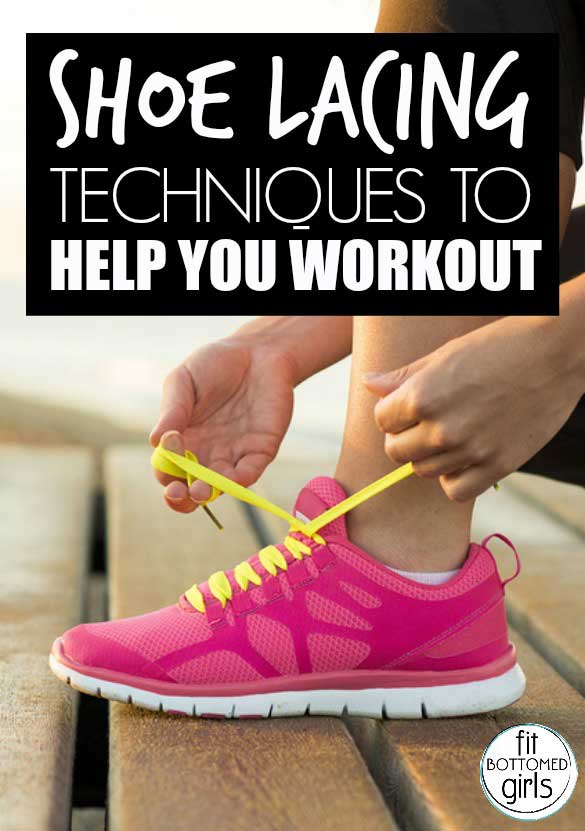The Lacing Lowdown: Shoe-Lacing Techniques to Help Your Workouts
 By now, you probably know that the footwear you work out in should be geared to the specific activity you’re doing. Running? Get you some running shoes. CrossFit? Try these. Dancing? Get thee some of these! But did you also know that your shoe-lacing technique can make a difference in the health of your foot and the quality of your workout? Yeppers! We recently got the low-down on lacing techniques from the Dana Point Turkey Trot and Mission Hospital and just had to spread the knowledge!
By now, you probably know that the footwear you work out in should be geared to the specific activity you’re doing. Running? Get you some running shoes. CrossFit? Try these. Dancing? Get thee some of these! But did you also know that your shoe-lacing technique can make a difference in the health of your foot and the quality of your workout? Yeppers! We recently got the low-down on lacing techniques from the Dana Point Turkey Trot and Mission Hospital and just had to spread the knowledge!
Athletic Shoes: The Importance of the Perfect Fit and Lacing Technique
You probably haven’t given much thought to the way you lace your shoes or sneakers. Shoe lacing is the kind of thing you learned in kindergarten and then took for granted. But according to Mission Hospital’s Devon Glazer, DPM, board certified podiatrist, “It’s just one of many simple things you can do to safeguard your feet while you put them through the demands of an athletic workout or even a long day of walking over all sorts of surfaces. Simply lacing your shoes or sneakers properly, along with choosing a shoe that fits your foot correctly, can add comfort to your stride and prevent foot injuries.”
Improper fit and poor lacing technique are a dangerous combination. They can cause a variety of foot ills, from blisters and hammertoes to chronic heel bruises and even stress fractures.
“When it comes to the shoes you use for your favorite athletic activity, there should be no compromises,” Dr. Glazer says. “Forget what you may have been told about buying snug-fitting athletic shoes that will break in with time. If the shoes don’t fit comfortably the first time you try them on, put them back and try on another pair.”
If possible, try on athletic shoes right after you’ve done the activity for which you’re buying the shoes because exercise makes your feet swell and will change the fit. Try running or walking to the shoe store. Another trick: Go to the shoe store at the end of the day, because that’s when your feet will be their largest from all the walking and standing you’ve done.
The Scoop on Buying Shoes
- Buy a shoe one-half inch longer than your longest toe.
- The forefoot should not be crowded; be sure your toes can extend.
- Be sure there’s a snug fit around the heel of the shoe.
- Your feet expand when bearing weight, so stand when your feet are measured.
- In many people, one foot is larger than the other. Shoes should be fitted to your longer and wider foot. Although the toe box should be spacious, too much space can make your feet slide, causing blisters.
Learn to Lace: Lacing Techniques
Once you’ve got the basic fit down, turn your attention to the laces. Here is the proper lacing technique:
1. Loosen the laces as you put on the shoes. This prevents stress on the eyelets and the backs of the shoes. In fact, take all the laces out when trying on a pair of shoes and re-lace with equal tension.
2. Always begin at the bottom and pull the laces using one set of eyelets at a time to tighten the shoes. This prevents stress at the tops of the shoes and aids a better fit.
3. When choosing shoes, keep in mind that those with more eyelets allow a more custom fit. Athletic shoes tend to allow more of a custom fit than, say, wingtips.
Lacing-Technique Tips
For wide feet: Use the eyelets closer to the tongue of the shoe. This allows greater width to the lacing area and has the same effect as letting out a corset.
For narrow heel and wider forefoot: A narrow heel and wider forefoot is a common problem among women. Consider using two laces for a combination fit. Use the closer set of eyelets to adjust the width of the shoe at the forefoot and the wider set to snug up the heel to prevent the heel from acting like a piston.
For foot pain: If you have a high arch, bump on the top of your foot, a bone that sticks out, nerve pain or tendon injury, try leaving a space in the lacing to alleviate pressure. Simply skip the eyelets near the point of pain.
Okay, now who learned something? I’m so in that narrow-heel-wider-forefoot camp and will so try this lacing technique trick! —Jenn
